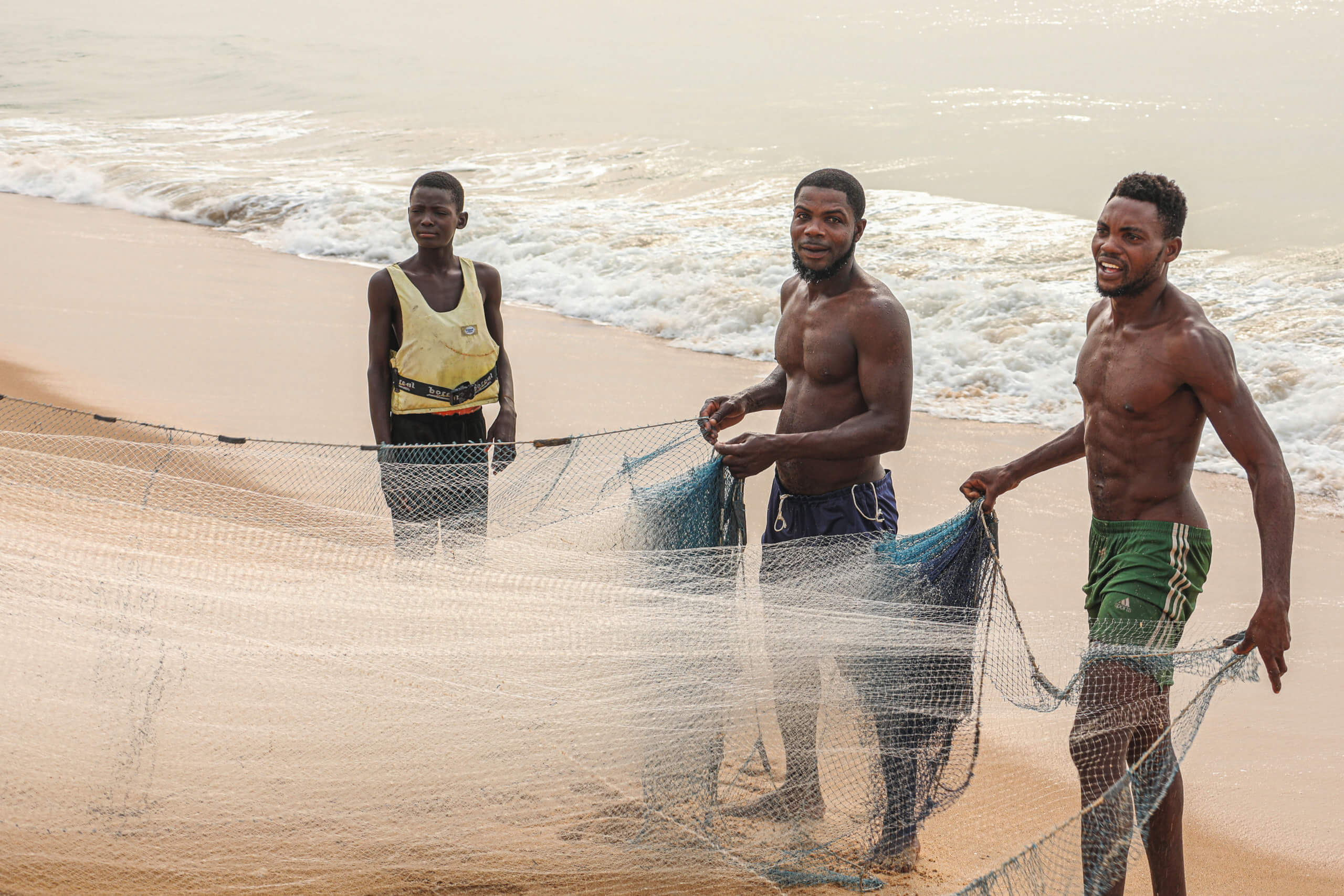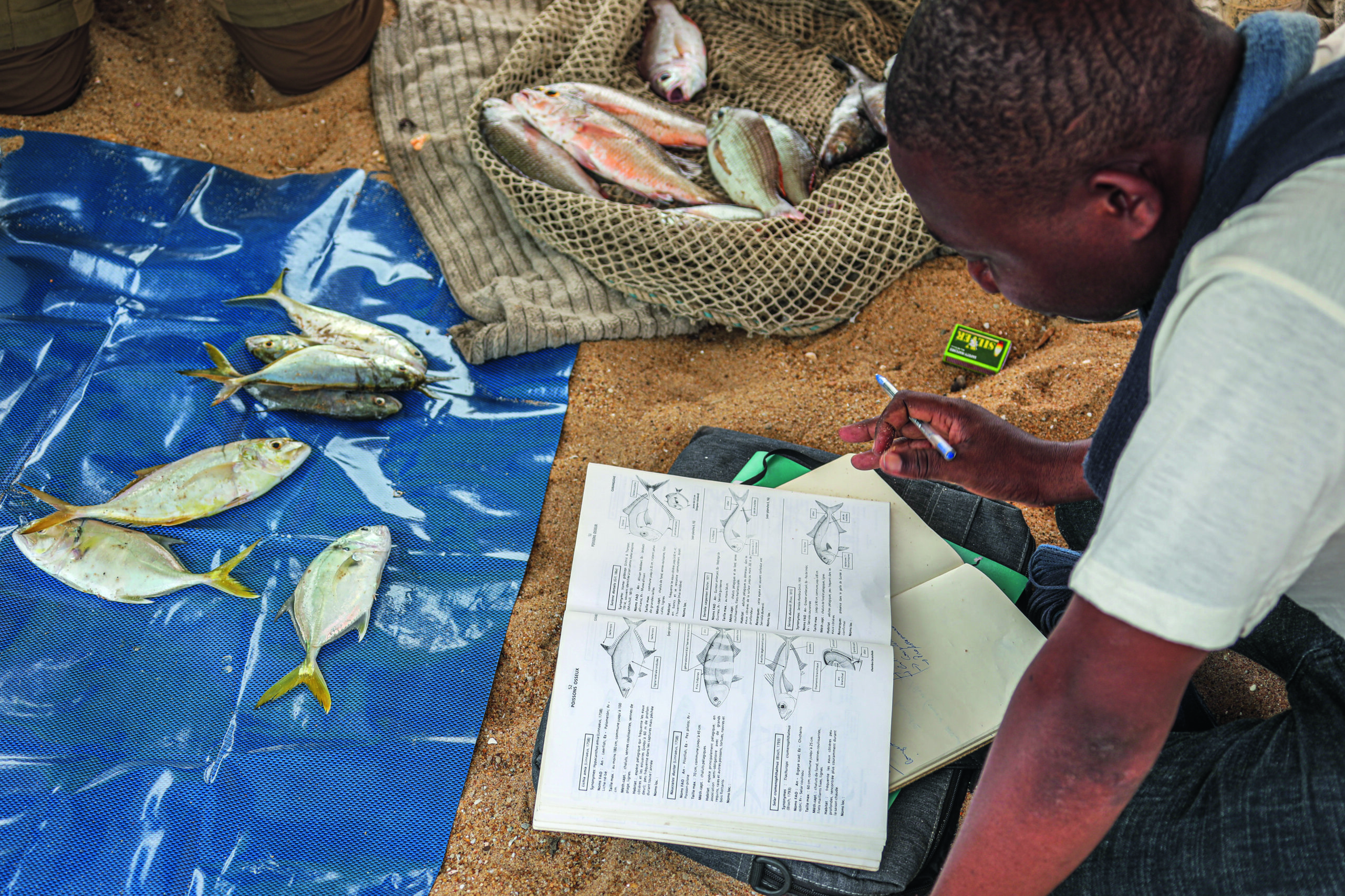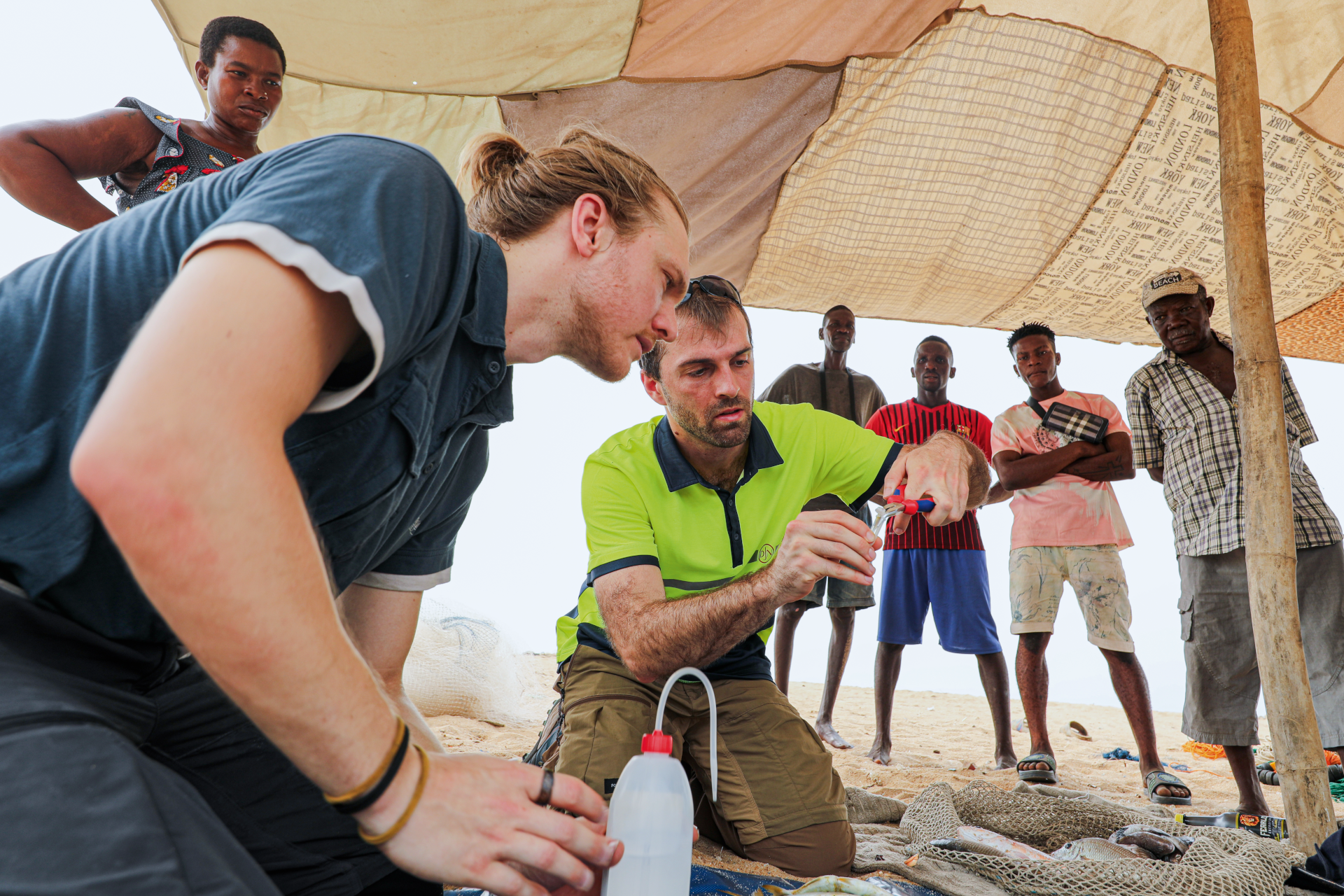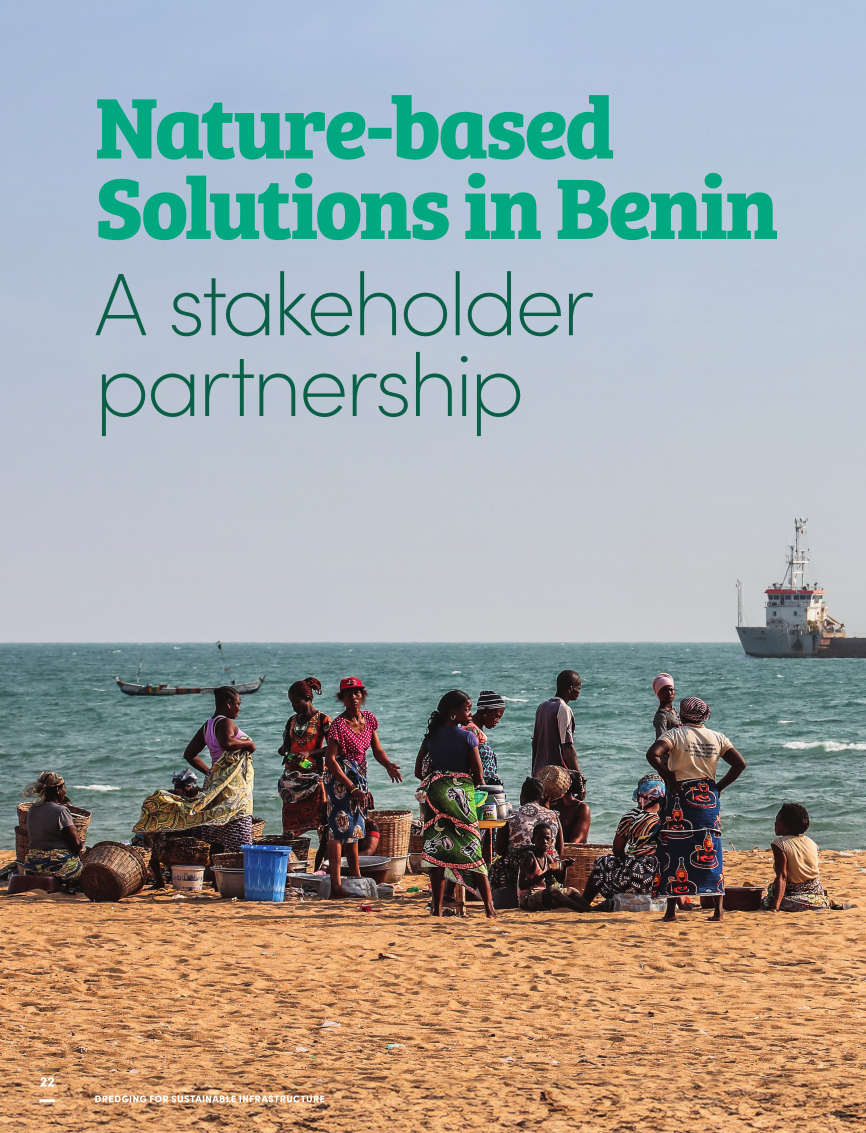Designing a submerged breakwater
Beach erosion is a well-known phenomenon along the West African coast. The consistent, monodirectional oceanic swell induces sand transport along the coast from west to east. Climatic change, sea level rise and human-made structures, such as river dams, groynes and breakwaters, disrupt this process. The breaking waves that drive this process also impose hazards to those wanting to swim or launch boats into the sea. These are just two groups who would therefore benefit from a milder wave climate.
Despite this general understanding of coastal processes, there is very little measured data available about the sand transport and its effects on the coast. Local knowledge institutions and researchers were contacted to assist in an extensive investigation into the driving forces and effects of existing structures. The groynes previously built perpendicular to the beach have proven to be inefficient in reducing erosion on Benin’s beaches. We therefore sought inspiration in nature’s most effective wave breaking structures: coral reefs. These natural structures combine three key functions that groynes do not provide: 1) they absorb wave energy; 2) they redirect it perpendicular to the coast; and 3) they host a rich ecosystem.
The concept design that resulted from this investigation consists of a submerged breakwater parallel to the coast at 150 metres off the existing low-water coastline. Its location and height were optimised in line with the depth and reach of the installation vessel. Its shape was finetuned with numerical and physical models in the Braunschweig Hydraulic Institute. The breakwater has two ingredients: a 1 to 500 kg foundation layer and a core of 1 to 3 tonnes of locally quarried rock units. These characteristics form a structure that does not hinder the open sea view and reduces the incoming wave energy on average by 60%. The swimming conditions score 3.8 on the Beach Safety Rating (Short and Hogan, 1994), a method adopted by the World Health Organization. This score corresponds to the 20 percentile of world’s safest beaches.
Local stakeholders
While the design concept may provide a solution to the project requirements, it affects the activities of the local fishing community. Local fishermen traditionally deploy long nets parallel to the coastline and retrieve them from both ends by pulling from the beach (“pêche à la senne de plage”). Another technique used is to deploy nets from canoes and retrieve them from the water (“pêche à la pirogue”). The economic situation of the fishing community is also precarious because of the steady decline of fish stock in Benin’s coastal waters.
To facilitate good relations with the community, we appointed a community relations officer who organised information and awareness committees. The purpose of the breakwater was explained and the benefits were highlighted: 1) The large rock units and the voids between them will create a new biodiverse and abundant ecosystem that can boost fish stocks; and 2) the mild wave climate at the leeward side of the submerged breakwater will attract recreational swimming and snorkelling, facilitating economic development, in particular ecotourism.
At first, the local fishermen were sceptical towards the breakwater construction because its presence would make the “pêche à la senne de plage” impossible and increase the sailing distance for their canoes. However, through continuous conversation, the fishing community became aware of the nature-related benefits. The fishermen shifted towards fishing with nets set out and retrieved from their canoes. Those who did not or could not shift their methods were financially compensated and provided with new land for use, allowing them to pursue alternative livelihoods. This comprehensive approach ensured that the needs and concerns of all stakeholders were addressed.
The benefits of a living biodiverse and bio-abundant reef extend beyond the local community. It is compliant to the sustainability objectives of the Ocean Panel (see www.oceanpanel.org) and the Green Globe Certified coastal resorts (see www.greenglobe.com).
Construction phase
The project started with a field survey that provided input data for the Environmental and Social Impact Assessment (ESIA). The ESIA was supervised by Antea group and ACL Consultants. The monitoring programme, set up in collaboration with the Benin Institute for Halieutic and Oceanographic Research (IRHOB) and the University of Abomey-Calavi (UAC), included a wide range of environmental and water quality parameters. 34 different benthic species were identified (mainly molluscs). In general, the impact assessment described the naturally occurring biodiversity of the benthic diversity to be low. Fish, sea turtles and marine mammals were described but not quantified.
The breakwater was built in three seasons, taking advantage of the mild climate between November and April. Starting in November 2018, 2 km of breakwater were installed in the first season. In the second season, the breakwater was extended westwards by another 2 km. The third season, completed in April 2021, saw 5.2 km of breakwater installed. In addition, sand was reclaimed on the eroded beach leeward of the constructed breakwater at the end of the second and third season.
Social impact actions
Taking advantage of the facilities during construction, the following three social impact actions were undertaken.
Rock Bujumbura
In 2019 and 2020, our installation vessel Pompei was mobilised with a special cargo. The Belgian not-for-profit organisation Rock Bujumbura collects and repairs musical instruments that have fallen out favour and gives them a second life in Rwanda, Togo or Benin. Our transport and technical department joined forces to safely package and store instruments onboard Pompei and our project team delivered them to three local music academies.
Beach cleanup
With the slogan “a leap day is a day won”, we organised a beach cleanup on 29 February 2020. Waste grabbers, shovels, rakes and reusable baskets were provided to 150 volunteers, who covered 48,000 m2 and collected 4.5 tonnes of waste.
Terres Rouges
After three years, our project staff said goodbye to the local community. As a token of appreciation, we donated our living and office furniture to Terres Rouges, a Belgian organisation committed to psychosocial care of neglected children in Benin. The furniture is being used to expand their shelters and help facilitate the operation.
Environmental monitoring campaigns
While we had evidence of past projects that the breakwater would soon become a biodiverse habitat that lives up to expectations, its evolution remains invisible and difficult to access. We have therefore organised three environmental monitoring campaigns in cooperation with our local partners.
2020 campaign
The first environmental monitoring campaign was organised in early 2020, just before the start of the sand reclamation. Near the breakwater we monitored environmental and water quality parameters, gained a general understanding on fish diversity through baited remote underwater videos (BRUV), organised two dive inspections for video footage of the breakwater itself and collected sediment samples near the breakwater for benthic analysis. The most important development was observed at the seaward side of the breakwater where several species associated with rocky environments – sea urchins, sponges, soft corals, juvenile hard corals, lime algae, crabs, barnacles and eels – were observed.
2021 campaign
In 2021, the scope and method of the second monitoring campaign were slightly adapted based on the lessons learned from the first campaign. The dive inspections were carried out by a team of spearfishermen that were used to the waves and currents near the breakwater allowing them to approach it to collect scrape samples. Nets were set out to monitor fish diversity and abundance, and interviews were conducted with the fishing community.
Combining local knowledge with European expertise, about 50 different fish species were observed, next to sea turtles, soft and hard corals, molluscs, sponges, lime algae and sea stars. There was a general scientific consensus that the submerged breakwater contributed to a substantial ecosystem development in terms of biodiversity and bio-abundance compared to the adjacent coastal stretches. The return of the considered disappeared commercial fish (including Pseudolithos sp or Cassava-drum), is probably the best indicator.
Interviews proved that the perception of the local fishing community had taken a turn for the better. The three main topics that were touched upon were: 1) adaptation of fishing techniques; 2) overall findings on fish catch before and after the breakwater construction; and 3) impacts of the breakwater on biodiversity and communities. The reappearance of commercial fish species convinced the community to see the nature-inspired design as a positive contributor. Their direct involvement in the fishing net surveys and close relationship with researchers of IRHOB also led them to have a better understanding and appreciation of the ecosystem benefits originating from the breakwater.
The increase in sea turtles nesting on the protected beach was considered as an added value for the planned ecotourism services provided by the submerged breakwater.
2024 campaign
The monitoring campaign was repeated in early 2024 and extended with an eDNA analysis performed by the Flemish institute of fisheries (ILVO). In total, 76 unique fish species were identified. 11 species were listed on the IUCN red list as near threatened or higher of which five species were exclusively found near the breakwater. The benthic analyses revealed over 200 different morphospecies including a wide array of reef-building species. The research concluded a large gap in diversity between a sandy reference location and the rich ecosystem correlated with the breakwater.
Interviews with the local fishing community were repeated. Their statements reinforced our belief that commitment to nature-inspired designs had become deeply rooted in the community. During their daily excursions on the water, the fishermen witnessed the restoration of marine biodiversity. They mentioned in particular the increase of sea turtle nests on the protected beach. Prioritising transparent communication facilitated our successful collaboration on this project. Fishermen who frequently fished near the breakwater had adapted their techniques in such a way that fishing is possible again by using shorter nets and reeling them in onboard their canoes.
Workshop
On 26 June 2024, a workshop was organised in cooperation with the Benin Institute for Halieutic and Oceanographic Research (IRHOB) and the Benin Centre for Scientific Research and Innovation (CBRSI) to present the findings of the three monitoring campaigns. The 66 attendees included journalists, researchers, fishermen, teachers, authorities and NGOs. The outcome of the biodiversity surveys was presented and discussions were held about the ecotourism potential, the ecosystem services for fishermen and tourism, the conservation and preservation of the fish habitat and the collaboration between stakeholders and the industry. The workshop was picked up in the media with two television news items, a radio interview a newspaper article and an online video.
For many stakeholders, the deep dive into the ecosystem services provided by the breakwater (e.g. tourism development, biodiversity enhancement, fisheries, coastal protection) turned out to be a revelation. The scientific institutions participating in the project found evidence in the presented findings that more data and understanding of the local fauna and flora would lead to better decisions, and a healthier, more sustainable and more attractive environment.
Future potential
The success of the workshop reassures us that we have reached the outcome that we aimed for: A solution that meets the client’s requirements, contributes positively to the local biodiversity and that is endorsed by a large stakeholder community. This project also shows that a contractor can do more than abide the contract specifications and legal requirements. The initiatives described in this article – the musical instruments, the beach cleanup, the office furniture, the monitoring campaigns and the workshop – were outside of our contractual scope. We did it because we thought it was the right thing to do.
We all wish that this project can be a showcase for a nature-based solution for a long time to come, but we are aware that there are obstacles on the way. A change in development plans, short-term economic gains, rivalry between political parties or between contractors, parasites or natural disasters, can all jeopardise and decimate this achievement. This is where the power of stakeholder management lies: now that the contractor has withdrawn from the project site, it is up to the stakeholders to stand ground.








